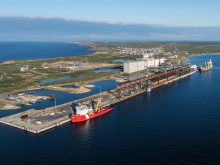Dispute hurts prices
The labor dispute at Fletcher’s Red Deer, Alta., plant has greatly reduced its kill rate.
Before the strike-lockout the plant slaughtered most of Alberta’s production. The Alberta hog marketing board has arranged to ship animals to packers in the United States and other prairie provinces, but the extra freight cost will cut into returns.
If the dispute drags on, basis levels will probably weaken across the Prairies.
Despite the turmoil in Alberta, hog prices rose during the week in response to higher wholesale pork prices in the United States. In Manitoba, prices rose about $12 per 100 kilograms during the week, hitting $153 per 100 kg on May 7.
Read Also

Geopolitics can change trade routes
WHISTLER, B.C. — Today’s geopolitical tensions could have dire long-term consequences, says the director of international policy at the University…
At these hog prices, even though pork values have risen, packer margins are squeezed, and analysts are doubtful that hog values can rise much more, given plentiful supplies.
Beef demand peaking
Fed cattle prices rose a little last week thanks to big demand from packers and consumers.
Canada’s national slaughter surpassed 66,000 head last week, the most since 1986. Alberta had its largest kill ever at 45,000.
Canfax said steers were $88-$90 per hundredweight and heifers $85-$90.
The market has improved significantly over the past few weeks, but Canfax believes the big beef buying spree for the holiday weekends in Canada and the United States has peaked.
Cattle weights are slowly falling (steers averaged 764 pounds) but are still higher than the 749 lb. they were last year at this time.
Canfax believes prices this week will be steady to $1 lower.
Cows traded steady last week on moderate volume and the outlook is for the same this week.
Feeder cattle prices were steady last week with some weight classes $1 per cwt. higher.
Volume was down by a third from the week before.
Canfax says feeder prices should hold steady through summer.
In the stock cow market a few bred cows traded at $850-$950, bred heifers were $500-$860 and cow/calf pairs were mostly $1,000-$1,250.














